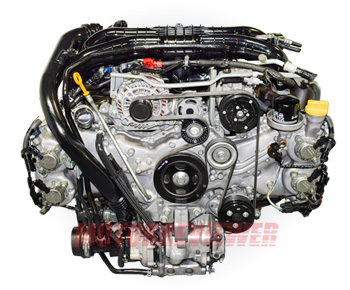Subaru FA20DIT 2.0L Turbo Engine Specs, Problems, Reliability, Info

Subaru FA20F/FA20DIT Overview
The FA20F engine, also known as the FA20DIT, made its debut in 2012 on the Japanese market under the hood of the JDM Subaru Legacy 2.0GT DIT model. It is a 2.0-liter, four-cylinder boxer engine with direct fuel injection and a twin-scroll turbocharger, which has replaced the older turbocharged versions from the EJ family, the EJ205/EJ207 engines. The FA20F engine has also been used in the 2014+ Subaru Forester (badged as the Forester XT model) and the 2015+ Subaru WRX. So how does it differ from the naturally aspirated FA20D used in the BRZ?
FA20F Engine Design
The FA20F/FA20DIT is built around the stock NA FA20 block. It is an open deck aluminum cylinder block with cast-in iron cylinder liners. The engine block features cast pistons with anti-friction skirt coating and asymmetrical, forged steel connecting rods. The design of the connecting rods is meant to reduce friction and wear on the cylinder walls and piston skirts during the compression stroke. The FA20 turbo comes with aluminum DOHC 8-valve (16 total) cylinder heads with roller rockers and Dual AVCS system. Camshafts are chain-driven (there are two single rollers timing chains). Intake valve diameter is 35 mm (1.38 in), exhaust valve diameter - 29 mm (1.14 in). The valve train doesn’t have hydraulic lifters. Valve covers are made from aluminum alloy.
This engine uses the direct fuel injection system, which shoots fuel directly into the cylinders. It features direct injectors inside heads and a high-pressure fuel pump, mounted on the left cylinder head, and it is driven by the intake camshaft. The intake manifold is made from plastic material. The intake also is equipped with Tumble Generator Valve (TGV) system. The exhaust system includes an equal-length exhaust manifold that feeds into a centrally-located, low-mounted, twin-scroll Garrett MGT2259S turbocharger. The compressed air is cooled by an air-to-air intercooler.
The End Result
Direct fuel injection technology has led to significant improvements in power output and fuel efficiency compared to its predecessors. Some stock JDM models produce up to 296 horsepower and 295 pound-feet of torque. The FA20F has also not gone unnoticed in the automotive industry. It was named to the Wards Auto "10 best engines" list in 2015 and 2016.
Engine Specs
Oil recommendations and capacity may vary depending on the car model, year, and market. Please check the service manual specific to your vehicle!
FA20DIT Engine Problems and Reliability
For its next generation of turbocharged Boxer engines, the FA series, Subaru has made several major design changes. Some of them have benefits, but some also have drawbacks.
- Many owners have noticed that the EJ engines are not as loud as FA engines. Direct injection injectors produce the most noticeable noise (a ticking sound), but pistons and pulleys also create noise.
- Direct injection requires premium gas and is very sensitive to the quality of fuel.
- The problem of carbon build-up in the intake affects many DI engines. To ensure the engine runs as efficiently as possible, we recommend cleaning the intake every 50-60k miles.
- Stock internal components cannot withstand a significant increase in power (more than 350 hp). The connecting rods are prone to bending or breaking, and the stock cast pistons are also not very strong.
Summary
The FA series is more complex than its predecessor, the EJ. The FA20DIT engine requires regular, proper maintenance, including the use of high-quality engine oil and high-octane fuel. Even that, these engines typically don't last more than 150,000 miles (250,000 km) without requiring major work.
